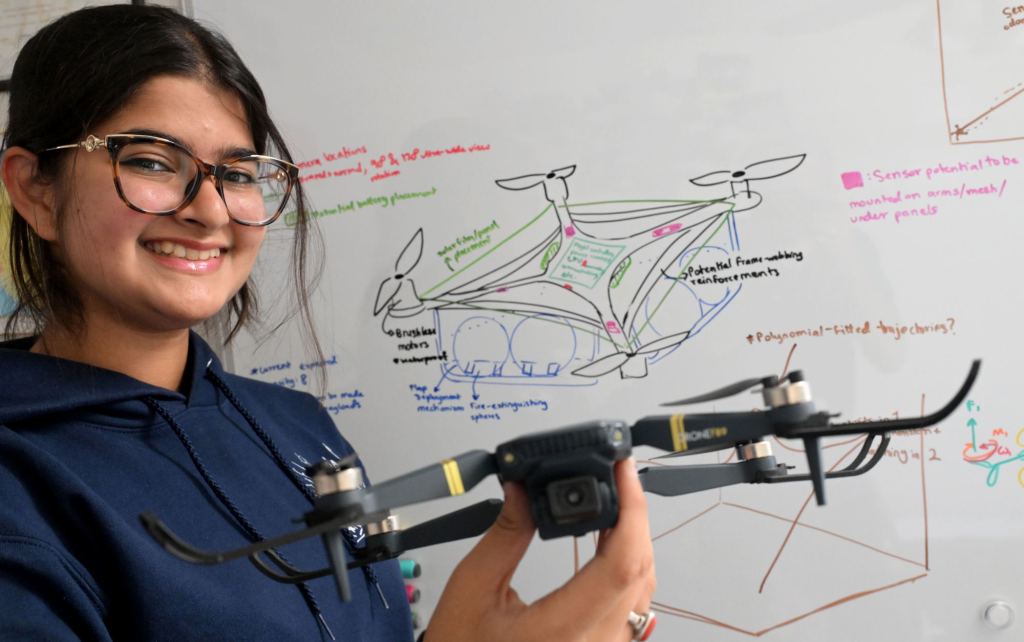High school student Anika Jha pulled an all-nighter the night before an English midterm last year. But she wasn’t cramming for the exam.
Instead, Jha spent the night researching and jotting down 15 pages of bullet-pointed notes — the seeds of a project she’d plan to dedicate her adolescence to.
“I was thinking about how terrible wildfires are and I discovered some awful statistics about how wildfires would grow almost twofold in the coming decades” Jha later said, recalling that night. “And so I made a brainstorming document.”
Now a sophomore at Arcadia High School, 15-year-old Jha is the inventor of Fire Drones, a prototype system designed to detect, monitor and suppress fires before they spread.
Jha drafted the idea for Fire Drones her freshman year, before the Eaton and Palisades fires exploded in the two regions on Jan. 7, destroying more than 16,000 structures and leaving 31 people dead — 12 in the Palisades and 19 in Altadena.
While the flames did not reach Jha’s Arcadia home, she says the “dystopian” image of roaring winds and ash are ingrained in her memory.
“I think being in that situation really showed me the importance of all the work that I’m doing. Having that personal connection makes all the difference to creating a better solution,” Jha said.
The Los Angeles fires are not the last to hit the West Coast this year.
In 2025 alone, there have been 5,362 reports of wildfires, totaling at least 354,878 acres burned and 16,344 structures destroyed.
And just last week on Aug 7, the Canyon fire, straddling the Los Angeles-Ventura county line near Val Verde west of Castaic, burned in a remote area east of Lake Piru. Initially estimated at about 30 acres, within two hours, the fire had burned through 1,051 acres of brush. It has currently scorched 5,370 acres.
Wildfires are increasing in frequency, severity and duration, with climate change creating extremely dry conditions, such as drought, heat waves and high winds, according to the World Health Organization.
Current approaches to managing wildfires involve detecting them afar and transferring rescue workers to use a combination of fire retardants and water to quell them. But Jha says the method needs updating.
Jha’s vision for Fire Drones: “solar-powered, autonomous drone systems running 24/7 over more remote areas where the wildfires usually start or spike and especially over dry regions.”
For an early model of the drone, Jha purchased a ready-made drone on Amazon to experiment with. She’s now working on coding and equipping the drone with sensor technology, infrared cameras and other components that would allow the drones to detect changes in the environment, as well as an AI algorithm that would feed them topography and weather information. And to directly combat fires, the drones will deploy bio-degradable, fire-extinguishing bombs to subdue the flames until personnel arrive.
For Fire Drones, Jha nabbed two first-place awards last year: NASA’s Dream With Us Design Challenge and the City of STEM Innovation Challenge in Los Angeles.

Officials at the California Department of Forestry and Fire Protection say they see a future where Jha’s drones are practically applied.
“It’s inspiring to see young innovators in our community developing tools to help protect lives and property,” officials said.
“This kind of creative thinking complements Cal Fire’s existing drone program, where we already use aerial platforms with heat-detection technology to locate hotspots and assess fire behavior. Advancements like this student’s prototype could enhance our efforts by improving early detection and wildfire reconnaissance as we continue to adapt to California’s changing fire environment.”
Jha is also behind apps focused on earthquake prediction and youth health, which she developed as part of the Technovation program. With users across more than 40 countries, the apps won Jha the Grand Prize and Technology Prize in the Technovation Girls competition and the Diana Award.
When she’s not coding, programming, inventing or simply in class, Jha enjoys exploring her creative side. She’s the author of two children’s books and practices art, ice skating, badminton and writing poetry in her spare time.
But she doesn’t plan on slowing down with Fire Drones. She’s still programming the hardware and sensors and working on the AI components. Her next step for the technology, she says is to reach out to and partner with fire prevention initiatives in California.
“The technology could be applied in all sorts of disasters from tsunamis to earthquakes, to even just 911 emergencies,” Jha said. “I wonder how many lives could be saved if we had aerial technology getting to places faster.”
Originally Published:






